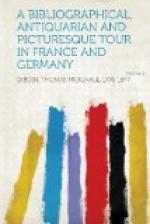[67] Bourgueville describes this river, in the sixteenth
century, as being
“aucune fois iaulne,
autrefois rouge, verte, bleuee, violee & autres
couleurs, selon qu’vn
grand nombre de teinturiers qui sont dessus, la
diuersifient par interualles
en faisant leurs maneures.” Antiquitez
de Caen, p. 36.
[68] expedition thither.]—When John
Evelyn visited this
neighbourhood, in 1644, “the
country so abounded with wolves, that a
shepherd, whom he met, told
him that one of his companions was
strangled by one of them the
day before—and that, in the midst of the
flock! The fields (continues
he) are mostly planted with pears and
apples and other cider fruits.
It is plentifully furnished with
quarries of stone and slate,
and hath iron in abundance.” Memoirs of
the Life and Writings of John
Evelyn, vol. i. p. 50. Edit. 1818. My
friend Mr. J. H. Markland
visited Mont St. Catharine the year after
the visit above described.
He was of course enchanted with the view;
and told me, that a friend
whom he met there, and who had travelled
pretty much in Italy, assured
him there was nothing like it on the
banks of either the Arno
or the Po. In short, it is quite peculiar
to itself—and cannot
be surpassed.
[69] It is thus prettily observed in the little Itineraire
de Rouen
—“Ces agreables
maisons de plaisance appartiennent a des habitants
de
Rouen qui y viennent en famille,
dans la belle saison, se delasser des
embarras de la ville et des
fatigues du commerce.” p. 153.
[70] race-ground]—When the English
cavalry were quartered here in
1814-5, the officers were
in the frequent habit of racing with each
other. These races were
gaily attended by the inhabitants; and I
heard, from more than one
mouth, the warmest commendations bestowed
upon the fleetness of the
coursers and the skill of the riders.
LETTER VIII.
EARLY TYPOGRAPHY AT ROUEN. MODERN PRINTERS.
CHAP BOOKS. BOOKSELLERS. BOOK
COLLECTORS.
Now for a little gossip and chit-chat about Paper, Ink, Books, Printing-Offices, and curiosities of a GRAPHIC description. Perhaps the most regular method would be to speak of a few of the principal Presses, before we take the productions of these presses into consideration. And first, as to the antiquity of printing in Rouen.[71] The art of printing is supposed to have been introduced here, by a citizen of the name of MAUFER, between the years 1470 and 1480. Some of the specimens of Rouen Missals and Breviaries, especially of those by MORIN, who was the second printer in this city, are very splendid. His device, which is not common, and rather striking, is here enclosed for your gratification.




